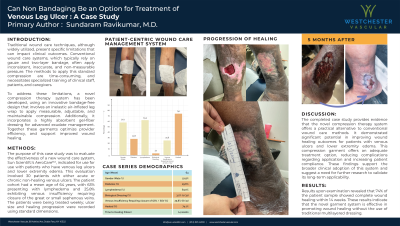Case Series/Study
(CS-132) Can Non Bandaging Be an Option for Treatment of Venous Leg Ulcer : A Case Study
Friday, May 2, 2025
7:45 PM - 8:45 PM East Coast USA Time

Kayla Johnson, B.S. – Westchester Vascular
Introduction:
Traditional wound care techniques, although widely utilized, present specific limitations that can impact clinical outcomes. Conventional, wound care systems, which typically rely on gauze and two-layer bandage, often apply inconsistent, inaccurate, and non-measurable pressure. The methods to apply this standard compression are time-consuming, and necessitates specialized training of clinical staff, patients, and caregivers. To address these limitations, a novel compression therapy system has been developed, using an innovative bandage-free design that involves an inelastic air-inflated leg wrap to apply measurable, adjustable, and maintainable compression. Additionally, it incorporates a highly absorbent gel-fiber dressing for advanced exudate management. Together these garments optimize provider efficiency, and support improved wound healing.
Methods:
The purpose of this case study was to evaluate the effectiveness of this new wound care system indicated for use with patients who have venous leg ulcers and lower extremity edema. This evaluation involved 30 patients with either acute or chronic non-healing venous ulcers. The patient cohort had a mean age of 64 years, with 63% presenting with lymphedema and 25.8% exhibiting venous insufficiency requiring closure of the great or small saphenous veins. The patients were being treated weekly; ulcer size and healing progression were recorded using standard dimensions.
Results:
Results upon examination revealed that 74% of the patient sample showed complete wound healing within 14 weeks. These results indicate that the novel garment system is effective in promoting wound healing without the use of traditional multilayered dressing.
Discussion:
The completed case study provides evidence that the novel compression therapy system offers a practical alternative to conventional wound care methods. It demonstrated significant potential in improving wound healing outcomes for patients with venous ulcers and lower extremity edema. This compression garment offers an adequate treatment option, reducing complications regarding application and increasing patient compliance. These findings support the broader clinical adoption of this system and suggest a need for further research to validate its long-term applicability.
Traditional wound care techniques, although widely utilized, present specific limitations that can impact clinical outcomes. Conventional, wound care systems, which typically rely on gauze and two-layer bandage, often apply inconsistent, inaccurate, and non-measurable pressure. The methods to apply this standard compression are time-consuming, and necessitates specialized training of clinical staff, patients, and caregivers. To address these limitations, a novel compression therapy system has been developed, using an innovative bandage-free design that involves an inelastic air-inflated leg wrap to apply measurable, adjustable, and maintainable compression. Additionally, it incorporates a highly absorbent gel-fiber dressing for advanced exudate management. Together these garments optimize provider efficiency, and support improved wound healing.
Methods:
The purpose of this case study was to evaluate the effectiveness of this new wound care system indicated for use with patients who have venous leg ulcers and lower extremity edema. This evaluation involved 30 patients with either acute or chronic non-healing venous ulcers. The patient cohort had a mean age of 64 years, with 63% presenting with lymphedema and 25.8% exhibiting venous insufficiency requiring closure of the great or small saphenous veins. The patients were being treated weekly; ulcer size and healing progression were recorded using standard dimensions.
Results:
Results upon examination revealed that 74% of the patient sample showed complete wound healing within 14 weeks. These results indicate that the novel garment system is effective in promoting wound healing without the use of traditional multilayered dressing.
Discussion:
The completed case study provides evidence that the novel compression therapy system offers a practical alternative to conventional wound care methods. It demonstrated significant potential in improving wound healing outcomes for patients with venous ulcers and lower extremity edema. This compression garment offers an adequate treatment option, reducing complications regarding application and increasing patient compliance. These findings support the broader clinical adoption of this system and suggest a need for further research to validate its long-term applicability.

.jpg)